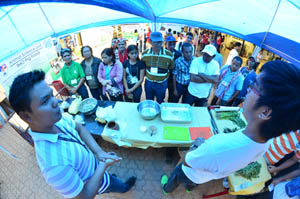 The College of Agriculture Research and Social Outreach conducted a 3-day Method Demonstration of agro-economic technologies from Feb 26-28 at the University Peace Park. The demo days gathered more than 300 students, community partners, LGU representatives and leaders from indigenous communities in Bukidnon.
The College of Agriculture Research and Social Outreach conducted a 3-day Method Demonstration of agro-economic technologies from Feb 26-28 at the University Peace Park. The demo days gathered more than 300 students, community partners, LGU representatives and leaders from indigenous communities in Bukidnon.
Demonstration is one of the most effective and economical means of spreading specific agro-technical extension messages in a short time, while at the same time popularizing these technologies to a diverse audience.
Seven units of the college participated in the demo days. A total of ten technical demonstrations specific to the Aggie departments’ and extension units’ expertise were showcased during the event. The Crop Science Unit demonstrated Aquaponics, the combination of Aquaculture (fish farming) and Hydroponics (soil-less growing of plants). It combines fish and plants in a "closed" integrated system. Closed means that there is no water loss since Aquaponics is a water efficient way of growing plants and fish. Added to that, they also presented different edible plants like Stevia “Stevia rebaudiana” and Ashitaba “Angelica keiskei”. Stevia which is a natural sweetener and Ashitaba are both a good source of health benefiting glycoside anti-oxidants, vitamins and minerals.
The Animal Science Unit demonstrated organic swine feeding using Indigenous Microorganisms (IMO). The participants were taught the basic steps in making IMO feeds as well as IMO beddings for swine. In order to deepen understanding of Agricultural Economics, the unit presented factors that can affect price and quantity demand and supply explaining them through a puppet show. The operation of a Solar Photovoltaic (SPV) system was demonstrated by the Affiliated Renewable Energy Center (AREC), the extension unit of the Agricultural Engineering Department. The SPV utilizes solar energy and converts it to electricity for household consumption.
Three Value Chain Analysis projects of students were presented by the Agribusiness Department. These include the creation of the common tapsilog meal to a lumpia roll called “Wrap and Roll” and value adding of sweet potato (camote) by making it into flavored chips. The Sea urchin Roe Pate (coined as Santeh), a winning product innovation of an Agribusiness student group, demonstrated how paste made of sea urchin roe can be turned into a gourmet product.
The Food Technology Department showed Bigas at Mongo or commonly known as BIGMO. BIGMO is a baby food, which combines rice (bigas), mung bean (Mongo) and sesame seeds. This is an innovation of the Food Technology Department and Department of Science and Technology-Food Nutrition Research Institute (DOST-FNRI) used for the feeding of malnourished babies in various relocation sites.
Finally, the Development Communication Department showcased how to popularize these technologies using media and the application of newscasting for science reporting. The participants were given tips on how to properly deliver development news to a target audience and how to conduct oneself when being interviewed in television.
The participants were highly appreciative of the event, giving the demo days a score of 4.40 out of 5.